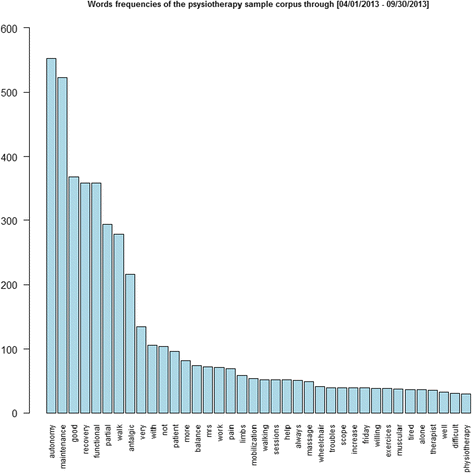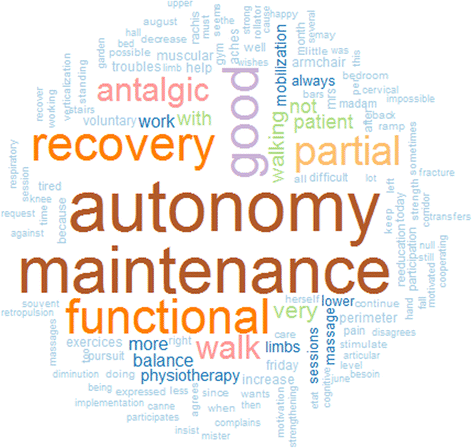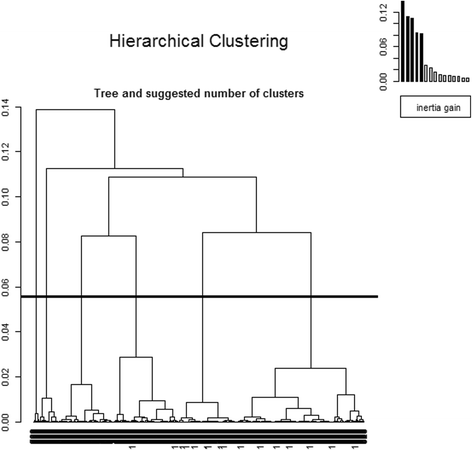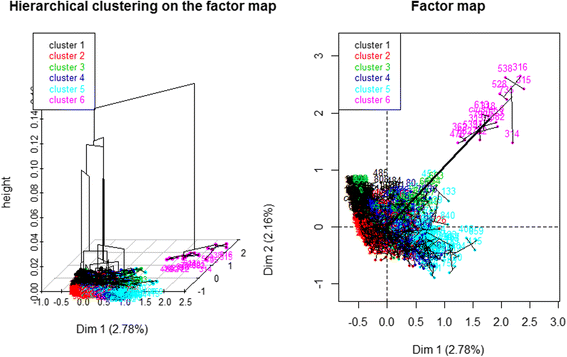Empirical advances with text mining of electronic health records
- PMID: 28830417
- PMCID: PMC5568397
- DOI: 10.1186/s12911-017-0519-0
Empirical advances with text mining of electronic health records
Abstract
Background: Korian is a private group specializing in medical accommodations for elderly and dependent people. A professional data warehouse (DWH) established in 2010 hosts all of the residents' data. Inside this information system (IS), clinical narratives (CNs) were used only by medical staff as a residents' care linking tool. The objective of this study was to show that, through qualitative and quantitative textual analysis of a relatively small physiotherapy and well-defined CN sample, it was possible to build a physiotherapy corpus and, through this process, generate a new body of knowledge by adding relevant information to describe the residents' care and lives.
Methods: Meaningful words were extracted through Standard Query Language (SQL) with the LIKE function and wildcards to perform pattern matching, followed by text mining and a word cloud using R® packages. Another step involved principal components and multiple correspondence analyses, plus clustering on the same residents' sample as well as on other health data using a health model measuring the residents' care level needs.
Results: By combining these techniques, physiotherapy treatments could be characterized by a list of constructed keywords, and the residents' health characteristics were built. Feeding defects or health outlier groups could be detected, physiotherapy residents' data and their health data were matched, and differences in health situations showed qualitative and quantitative differences in physiotherapy narratives.
Conclusions: This textual experiment using a textual process in two stages showed that text mining and data mining techniques provide convenient tools to improve residents' health and quality of care by adding new, simple, useable data to the electronic health record (EHR). When used with a normalized physiotherapy problem list, text mining through information extraction (IE), named entity recognition (NER) and data mining (DM) can provide a real advantage to describe health care, adding new medical material and helping to integrate the EHR system into the health staff work environment.
Keywords: Data mining; Hierarchical clustering; Information extraction; Multiple component analysis; Named entity recognition; Nursing homes; Principal component analysis; SQL query; Text mining; Word cloud.
Conflict of interest statement
Ethics approval and consent to participate
The use of this database in the frame of epidemiological studies has been authorized by the French National Commission for Data protection and Liberties (CNIL). The Institut du Bien Vieillir filed a declaration of conformity to a baseline methodology which received in March 2017 an agreement number: 2.041.050, in accordance with the Act n°78–17 of 6 January 1978 on Data Processing, Data Files and Individual Liberties. All residents are informed at their NH entry about their EHR and their right to oppose its use. While the primary purpose of this medical research was to generate new knowledge, this goal didn’t take precedence over the rights and interests of the NH residents. All the new generated information was extracted from already existing data and was de-identified and anonymized when necessary to protect their health and rights. There were no images and no identifying details on individuals reported within this manuscript
Consent for publication
Not applicable.
Competing interests
The authors do not have any financial or non-financial competing interests to report. Funding to support TD’s work is reported above.
Publisher’s Note
Springer Nature remains neutral with regard to jurisdictional claims in published maps and institutional affiliations.
Figures







References
-
- Maas ML, Delaney C. Nursing process outcome linkage research: issues, current status, and health policy implications. Med Care. 2004;42(2):II-40–II-48. - PubMed
-
- Ventres W, Kooienga S, Vuckovic N, et al. Physicians, Patients, and the Electronic Health Record: An Ethnographic Analysis Annals of Family Medecine, n°2 March/April. 2006;4:124–32. www.annfammed.org. - PMC - PubMed
Publication types
MeSH terms
LinkOut - more resources
Full Text Sources
Other Literature Sources

